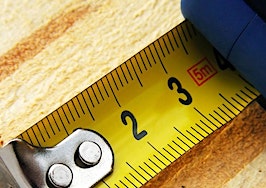- Amid a continually rising tide of homebuilder confidence nationally, residential construction dropped a bit, by 2 percent.
- Nonresidential slid only 28 percent from 2014’s cumulative number to September, while residential has gained a healthy 32 percent in the same time period.
- The area studied is the metropolitan statistical area of Chicago-Naperville-Joliet.
Call it a pause, a hiccup or no big deal, residential housing starts stuttered a bit in September.
Construction data deep thinkers Dodge Data & Analytics recently cranked out its monthly tallies on overall construction in Chicagoland, and the data show a big divot in non-home building, and maybe a double bogey for residential construction.
Amid a continually rising tide of homebuilder confidence nationally, residential construction dropped a bit, by 2 percent. Still a big number, the value of that construction from the same period last year went from just over $362 million to about $353.5 million this September.
The National Association of Home Builders’ confidence benchmark went up three points in October to 64. The index has been in the 60s since June, a sign of momentum that the group says is the best since 2005.
Chicagoland’s building boom went bust year-over-year on the nonresidential side, dropping 54 percent. Since the drop was so large, residential and nonresidential building dollar totals are almost the same. This year, the construction for almost anything other than homes totaled about $339 million, a steep drop from September 2014’s $734 million.
[Tweet “Chicagoland’s building boom dropped on the nonresidential side by 54 percent”]
The small drop in residential building tempered the slide in the nonresidential side. The total percentage drop is 37 percent.
And, it’s the time of year when construction of anything slows down anyway, especially in parts of the country that count their snow totals in feet. And need to store their golf clubs soon.
The area studied is the metropolitan statistical area of Chicago-Naperville-Joliet. This consists of Cook, De Kalb, Du Page, Grundy, Jasper, Kane, Kendall, Kenosha, Lake, McHenry, Newton, Porter and Will counties, which nose into Indiana and Wisconsin.
Cumulative year-to-date numbers are more rosy. Nonresidential slid only 28 percent from 2014’s cumulative number to September, while residential has gained a healthy 32 percent in the same time period. Taken together, that’s only a 9 percent loss.
For those who like really big numbers, these are in the billions for this market: Total construction is just over $7 billion cumulatively for 2015, and last year it was $7.7 billion.
Nonresidential buildings include office, retail, hotels, warehouses, manufacturing, educational, healthcare, religious, government, recreational and others. Residential buildings include single family and multifamily housing.
How does this stack up against the rest of the hammering and drilling that’s going on in the rest of the country? According to the U.S. Census Bureau, Spending on private construction as a whole was at an annual rate of $794.2 billion. Residential construction was at a seasonally annual rate of $394.7 billion in September, and nonresidential building was at a seasonally adjusted annual rate of $399.5 billion.
So, although not quite an apples-to-apples comparison, the Chicago area accounts for about 10 percent of the construction across the nation.
Dodge’s long-term national prediction for construction in 2016 says that activity will continue to grow next year, but not at the same clip that building in 2015 increased.





